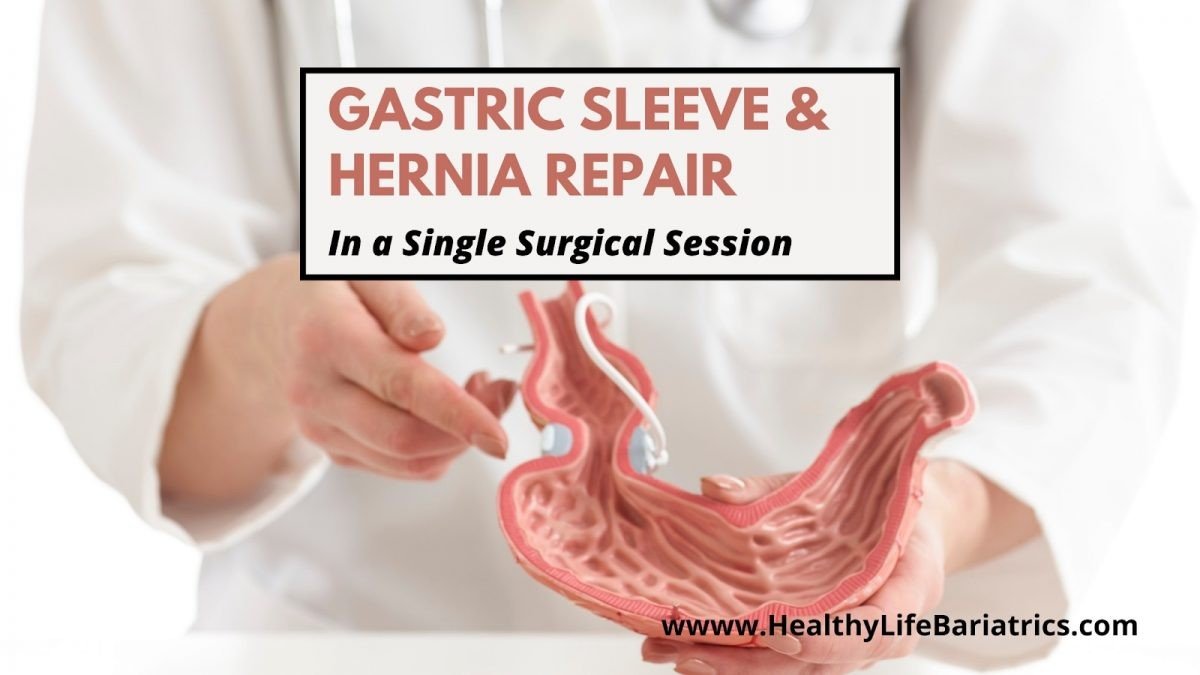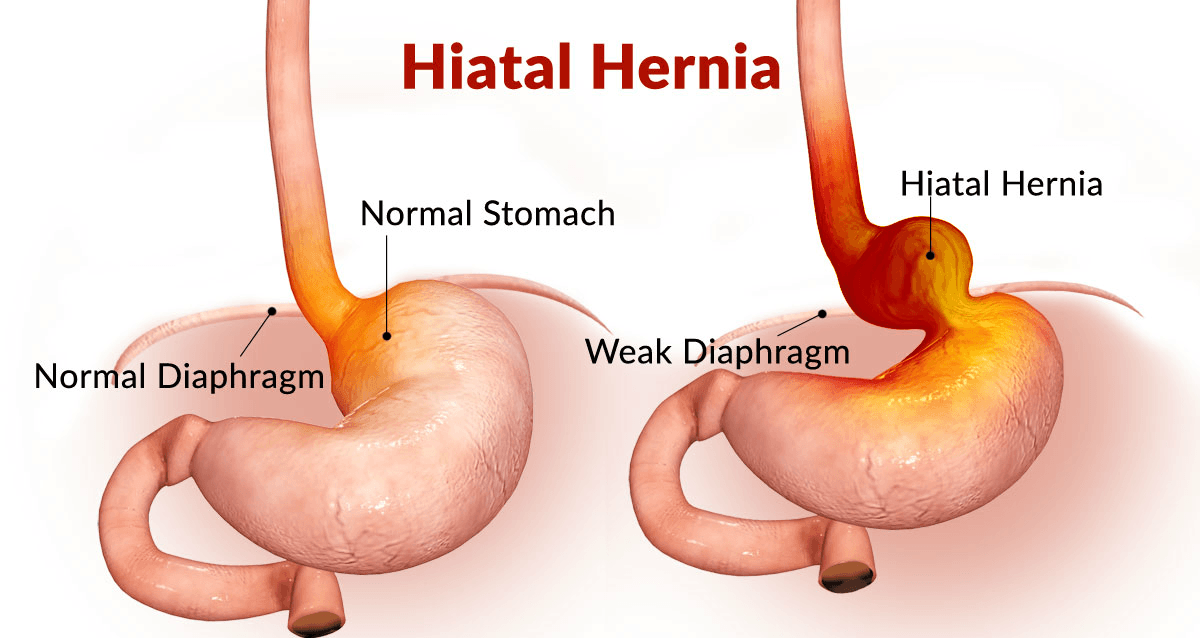
Not many people know that hiatal hernia repair surgery and the sleeve gastrectomy (gastric sleeve) can be combined into a single procedure.
If you suffer from morbid obesity and want to repair your hernia while fighting obesity with the gastric sleeve, you’ll want to request a single surgical session for both techniques.
Here is everything you need to know about the two-in-one hernia repair and bariatric surgery combination that can save you time and money while simultaneously improving your health.
Before we begin exploring how these two amazing procedures work together, it helps to define them one at a time. Let’s start with Hiatal hernias, which tend to be more common in morbidly obese patients.
A hiatal hernia (or hiatus hernia) happens when the upper part of your stomach bulges through the muscles separating your chest from your abdomen. That area of your chest is known as the diaphragm. It contains a small opening, referred to as a hiatus, where food passes through the esophagus on its way to your stomach.
When you have a hiatal hernia, your stomach pushes through the hiatus and into your chest.
Most people experience no symptoms from this bulging of the stomach and separation of the muscle. You might only discover you need hernia repair surgery when your doctor is checking for something else, such as your eligibility for gastric sleeve surgery.
Then there are people with extreme heartburn caused by a hiatal hernia. If you are one of these people, you may also experience gastroesophageal reflux disease (GERD), which is when food and acid become regurgitated into the esophagus.
The esophagus usually has sphincter muscles that can close to prevent backup. The hiatal hernia prevents the sphincters from closing properly, leading to heartburn that doesn’t seem to go away.
While heartburn and acid reflux are common experiences, if you are morbidly obese, these symptoms may indicate a more serious problem. Hiatal hernias can cause frequent and intense heartburn and if left untreated, surgery is often needed.

You may be wondering how a hernia begins in the first place. You don’t just wake up one day with your stomach pushing through your chest and causing problems, though you could be born with a larger hiatal opening.
Morbid obese patients have a 50% chance of developing a hiatal hernia (and GERD). The condition can be caused by a variety of factors, mostly increased pressure on the abdomen, which in turn can be caused by extreme vomiting, straining during bowel movements, and heavy lifting. Hacking bouts of coughing can also cause you to develop a hiatal hernia.
Pregnant and obese women are also at a higher risk of developing a hiatal hernia.
One of the more popular bariatric surgeries to date is called the Gastric Sleeve, or laparoscopic sleeve gastrectomy. This surgery will shrink your stomach to limit your food intake, allow you to feel full faster, and ultimately results in major weight loss.
The surgery is incredibly popular for the treatment of obesity and is backed by the FDA. Most importantly, the surgery can lead to long-term weight loss, but only if the obese patient follows a healthy lifestyle.
How is the Hiatal Hernia Repaired?
The goal of hiatal hernia surgery is to pull your stomach back into your abdomen while simultaneously making the diaphragm opening smaller. The procedure can also involve the reconstruction of the esophageal sphincter or the removal of hernia sacks.
The surgery is performed laparoscopically via tiny incisions made in your abdomen. Because the surgery is minimally invasive in nature, it comes with a quick recovery period and a decreased risk of infection.
Your surgeon will make between three and five incisions in your abdomen that will act as openings for the surgical instruments.
Your surgeon’s actions will be guided by the laparoscope and shown on an HD monitor positioned nearby. This allows the doctor to view your internal organs and pull your stomach back to the desired position, where it belongs.
Your doctor will wrap the upper part of your stomach around the lower part of the esophagus. The result is a tighter sphincter that prevents acid reflux from recurring.
The hiatal hernia repair surgery has a 90% success rate. However, and unfortunately, 30% of people will experience a return of their acid reflux symptoms.
We can perform the gastric sleeve using the same laparoscopic instruments. Either before or after the hernia has been repaired, your bariatric surgeon will begin on your sleeve gastrectomy.
Your surgeon will begin by removing 75% of your stomach, which leaves behind a narrow tube. The tube looks like a sleeve, which is where LSG gets its name. This sleeve looks like a banana and will be used to store the food you eat before digestion occurs.
Unlike some bariatric procedures like the gastric bypass, where your digestive process is rerouted, the gastric sleeve doesn’t work this way. Only your stomach is affected.
The surgical session lasts up to two hours and will leave you with limited stomach space to help you adopt healthier eating habits. You won’t be able to help but eat smaller, healthier portions. At the same time, the resulting hormonal changes cause you to feel less hungry and “fuller” faster whenever you are eating. There are many benefits to surgery, including fast and safe long-term weight loss.

Does the procedure work together? In 2010, a study was conducted over a period of 18 months that followed eleven obese patients after undergoing laparoscopic sleeve gastrectomy (LSG) and Hiatal Hernia Repair (HHR). The mean weight between all the participants was roughly 276 lbs. with a body mass index (BMI) of 44.75.
Ten out of the eleven patients had GERD. One patient had no symptoms at all. That person’s hernia was only discovered during an unrelated surgery.
In addition to GERD, five of the patients showed evidence of chronic gastritis.
All the patients were treated with LSG and HH with none showing any signs of complications.
The surgical procedures combined together offer excellent results. Eight of the eleven patients stopped experiencing GERD symptoms entirely after the operation.
Four of the six quit taking their anti-reflux medication.
Two patients had a decrease in symptoms but continued using proton pump inhibitors.
The study research staff concluded that the combination of LSG with HHR is not only safe but provides excellent outcomes for patients with morbid obesity and GERD.
Undergoing sleeve gastrectomy will set you back about $17,500, on average. The surgery to repair a hiatus hernia costs around $5,000. Combining the surgeries should come with a healthy discount. Schedule a consultation with a qualified bariatric surgeon to get a more accurate quote.
Simultaneous repair and gastric sleeve surgery both come with their own sets of risks. You have the typical risks that accompany any surgery, such as infection, but both of these surgeries are common and safe in the hands of a qualified surgeon.
Your first step to gaining independence from GERD is to have reflux surgery in the form of this effective bariatric combination. Combining hiatal hernia repair surgery and gastric sleeve surgery helps you live a life free of obesity and acid reflux.
Dr. Moeinolmolki of Healthy Life Bariatrics invites you to schedule a virtual consultation with him to discuss HHR and LSG.
If you have a high body mass index and are experiencing hiatal hernia symptoms like GERD or more extreme symptoms like bleeding, call 310-861-4093 and book a time that works best for you.